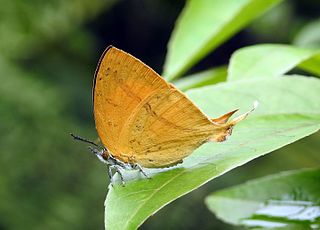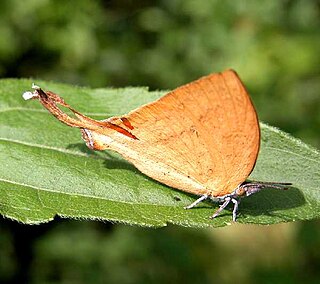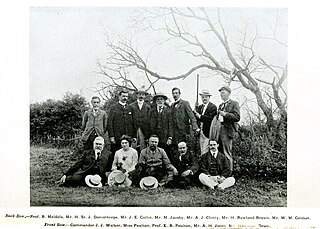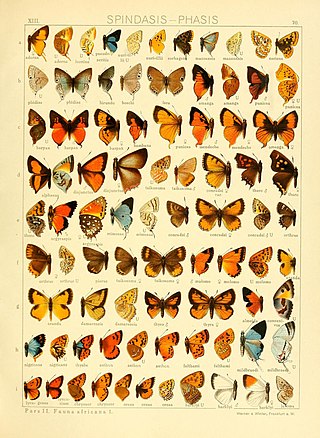
The superfamily Papilionoidea contains all the butterflies except for the moth-like Hedyloidea.

Lycaenidae is the second-largest family of butterflies, with over 6,000 species worldwide, whose members are also called gossamer-winged butterflies. They constitute about 30% of the known butterfly species.

Riodinidae is the family of metalmark butterflies. The common name "metalmarks" refers to the small, metallic-looking spots commonly found on their wings. The 1,532 species are placed in 146 genera. Although mostly Neotropical in distribution, the family is also represented both in the Nearctic, Palearctic, Australasian (Dicallaneura), Afrotropic, and Indomalayan realms.

The subfamily Theclinae is a group of butterflies, often referred to as hairstreaks, with some species instead known as elfins or by other names. The group is part of the family Lycaenidae, the "gossamer-winged butterflies". There are many tropical species as well as a number found in the Americas. Tropical hairstreaks often have iridescent blue coloration above, caused by reflected light from the structure of the wing scales rather than by pigment. Hairstreaks from North America are commonly brown above. Few Theclinae are migratory. Members of this group are described as 'thecline'.

Miletinae is a subfamily of the family Lycaenidae of butterflies, commonly called harvesters and woolly legs, and virtually unique among butterflies in having predatory larvae. Miletinae are entirely aphytophagous. The ecology of the Miletinae is little understood, but adults and larvae live in association with ants, and most known species feed on Hemiptera, though some, like Liphyra, feed on the ants themselves. The butterflies, ants, and hemipterans, in some cases, seem to have complex symbiotic relationships benefiting all.

Loxura atymnus, the yamfly, is a species of lycaenid or blue butterfly found in Asia.

The Loxurini are a small tribe of butterflies in the family Lycaenidae.

The Aphnaeinae are a subfamily of butterflies in the family Lycaenidae.

Lachnocnema, commonly called woolly legs, is a genus of butterflies in the family Lycaenidae found mainly in Sub-Saharan Africa. Identification requires dissection to reveal subtle genital distinctions.

Lipaphnaeus is an Afrotropical genus of butterflies in the family Lycaenidae. The genus was erected by Per Olof Christopher Aurivillius in 1916.

Loxura is a genus of butterflies in the family Lycaenidae. The species in this genus are found in the Indomalayan realm.

Zizeeria knysna, the dark grass blue or African grass blue, is a species of blue butterfly (Lycaenidae) found in Africa, on Cyprus and the Iberian Peninsula.

Rachana is a genus of butterflies in the family Lycaenidae.

Hamilton Herbert Charles James Druce was an English entomologist who specialised in Lycaenidae and to a lesser extent Hesperiidae. He is not to be confused with his father, the English entomologist Herbert Druce (1846–1913) who also worked on Lepidoptera.

Lipaphnaeus aderna, the bramble false hairstreak or blue silver speckle, is a butterfly in the family Lycaenidae. It is found in Sierra Leone, Liberia, Ivory Coast, Ghana, Nigeria, Cameroon, the Democratic Republic of the Congo, Uganda, Kenya, Tanzania, Malawi, Mozambique and Zimbabwe. The habitat consists of forests and dense savanna.
Lipaphnaeus eustorgia is a butterfly in the family Lycaenidae. It is found in the Democratic Republic of the Congo, Tanzania and Zambia.

Lipaphnaeus leonina, the orange silver speckle, is a butterfly in the family Lycaenidae. It is found in Guinea, Sierra Leone, Liberia, Ivory Coast, Ghana, Togo, Benin, Nigeria, Cameroon, the Republic of the Congo, the Democratic Republic of the Congo, Uganda, Tanzania and Zambia. The habitat consists of forests.

Mimacraea krausei, the Krause's acraea mimic, is a butterfly in the family Lycaenidae. It is found in Cameroon, the Republic of the Congo, the Democratic Republic of the Congo, Sudan, Uganda, Kenya and Tanzania. The habitat consists of forests.

Loxura cassiopeia is a butterfly in the family Lycaenidae.It was described by William Lucas Distant in 1884. It is found in the Indomalayan realm.















